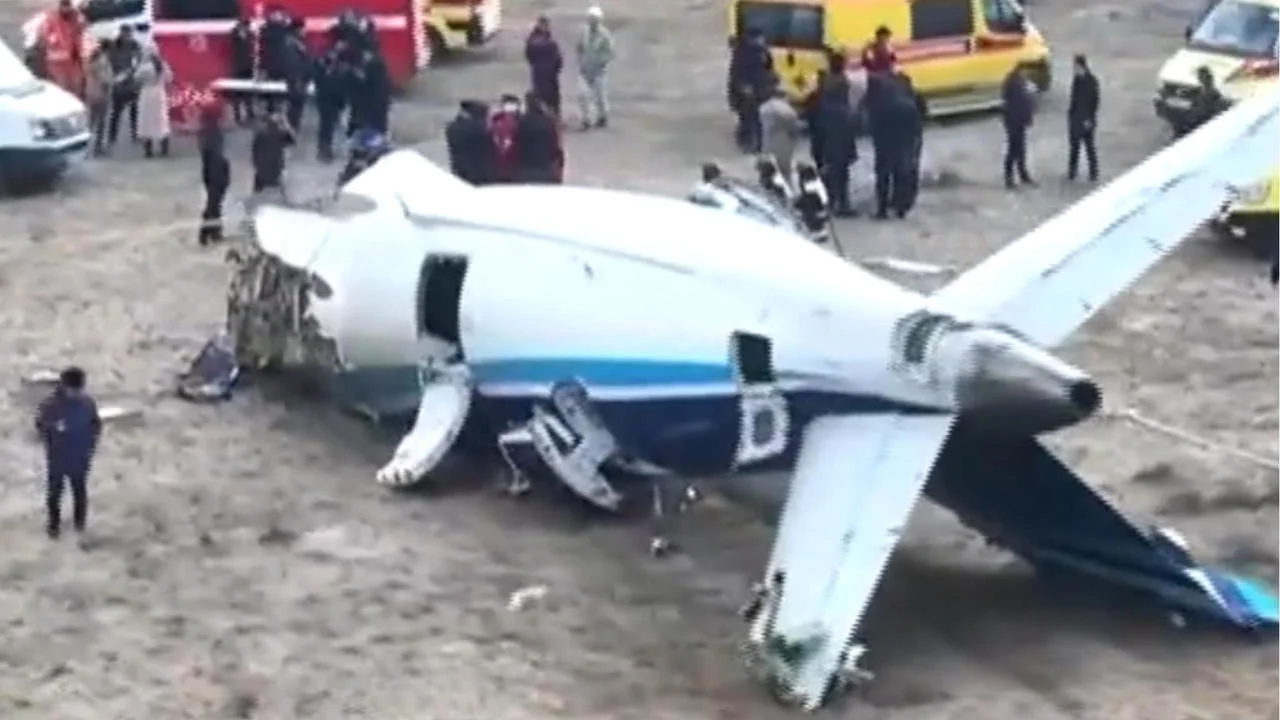On Thursday, Azerbaijan observed a nationwide day of mourning for the victims of the plane crash that claimed 38 lives and injured 29 survivors. As speculation rose about the cause of the disaster, questions emerged about the potential involvement of Russian air defense operations.
The Azerbaijan Airlines Embraer 190 was traveling from Baku, Azerbaijan’s capital, to Grozny in Russia’s North Caucasus region on Wednesday when it was unexpectedly diverted for unknown reasons. The aircraft crashed while attempting to land in Aktau, located in western Kazakhstan, after crossing the Caspian Sea. The crash site was approximately 2 miles from Aktau.
A U.S. official, speaking to CBS News on condition of anonymity, indicated that there are early signs suggesting the plane might have been struck by a Russian anti-aircraft system. If confirmed, this would highlight the dangerous implications of Russian actions during its invasion of Ukraine.
Cellphone footage circulating online appears to show the aircraft descending steeply before crashing into the ground in a fireball. Additional footage and photos depict part of the fuselage torn away from the wings and the rear half of the aircraft lying upside down in the grass.
During a news conference on Wednesday, Azerbaijani President Ilham Aliyev stated it was too early to speculate on the crash’s cause but noted that weather conditions had forced the plane to deviate from its planned route.
“The information provided to me indicates that the plane altered its course between Baku and Grozny due to worsening weather conditions and headed to Aktau airport, where it crashed upon landing,” he said.
Russia’s civil aviation authority, Rosaviatsia, reported that preliminary information suggested the pilots diverted to Aktau following a bird strike that caused an onboard emergency.
The subsequent events remain unclear.
A regional official in Kazakhstan suggested on Thursday that the investigation is considering the possibility that Russian air defenses may have downed the plane. Abylaibek Ordabayev, the Mangystau Regional Transport Prosecutor, stated that no conclusions have been reached yet regarding this theory, as reported by Reuters.
Russian Anti-Aircraft Systems Under Scrutiny
As the official crash investigation commenced, various theories emerged regarding the cause. Some analysts speculated that damage observed in the plane’s tail section might indicate it was targeted by Russian air defense systems, similar to those employed against Ukrainian drone attacks.
In the past, Ukrainian drones have attacked Grozny, the capital of the Russian republic of Chechnya, and other areas in the North Caucasus region. Some Russian media outlets reported another drone attack on Chechnya on Wednesday, although this has not been officially confirmed.
Yan Matveyev, an independent Russian military expert, observed that the damage visible on the crashed plane’s tail is consistent with shrapnel from small surface-to-air missiles, such as those used by the Pantsyr-S1 air defense system.
“It appears that the tail section of the plane was damaged by missile fragments,” he stated.
Osprey Flight Solutions, a UK-based aviation security firm, alerted its clients that the Azerbaijan Airlines flight was “likely shot down by a Russian military air-defense system.” Osprey provides analysis for carriers that continue to operate in Russia after Western airlines halted their flights due to the war in Ukraine.
Andrew Nicholson, CEO of Osprey, mentioned that the company has issued over 200 alerts regarding drone attacks and air defense systems in Russia during the conflict.
“This incident serves as a stark reminder of the importance of our work,” Nicholson wrote online. “It is deeply painful to realize that despite our efforts, lives were lost in a manner that could have been prevented.”
Russian military expert Yury Podolyaka, quoted by Agence France-Presse, noted that the holes observed in the plane’s wreckage were consistent with those caused by an “anti-aircraft missile system.” “Everything points to that,” he wrote.
Gerard Legauffre, a former expert at France’s BEA air accident investigation agency, also indicated that the wreckage appeared to exhibit “a lot of shrapnel” damage, according to AFP.
He described it as “reminiscent” of Malaysia Airlines flight MH17, which was downed by a surface-to-air missile launched by Russia-backed rebels over eastern Ukraine in 2014.
When questioned about the allegations that the plane was targeted by air defense systems, Kremlin spokesman Dmitry Peskov told reporters, “It would be premature to speculate before the investigators reach a conclusion.”
Kazakhstan’s parliamentary Speaker Maulen Ashimbayev also cautioned against drawing conclusions from images of the plane’s debris, labeling the claims of air defense involvement as baseless and “unethical.”
Officials in both Kazakhstan and Azerbaijan have refrained from commenting on the potential cause of the crash, emphasizing that it is up to investigators to determine the facts.
In Azerbaijan, national flags were lowered on Thursday, and a nationwide moment of silence was observed at noon, with traffic coming to a halt and signals sounded from ships and trains across the country.
